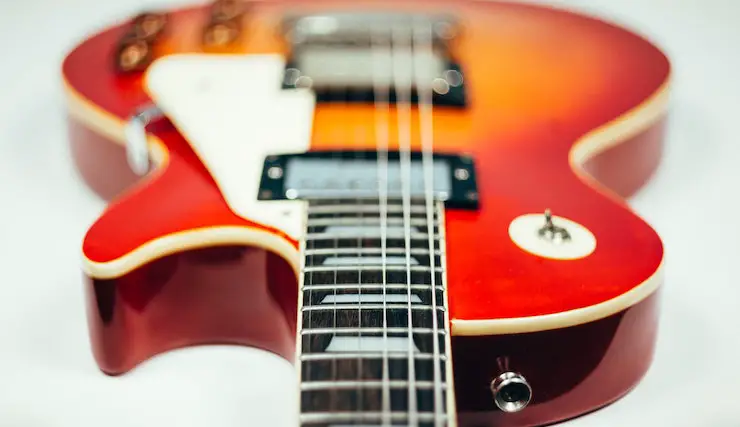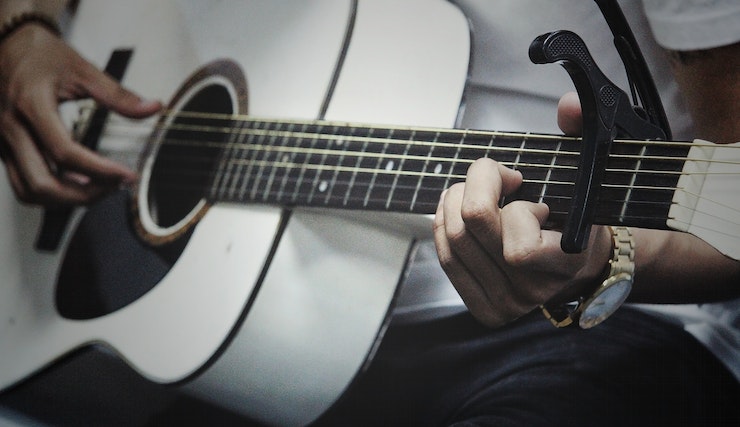What Does H Mean In Guitar Tabs?
The tablature of the guitar is indicated using the initial letter “H,” as seen in the figure below. It begins with a hammering-on at the 5th fret up to eight frets on low E strings.
In guitar tabs, “h” is the first letter of “h”, representing a hammer-on technique. Hammer-on is the method that guitarists employ to create an even and seamless sound that is produced by the two notes without picking each note separately. If you see the “h” letter in a guitar tab, you must use “h” in a guitar tab; this means you need to play the note that is indicated in “h” by quickly pressing down on the fretboard using the fingers of your fretting hand. This creates the sound without playing the string differently.
This method is accomplished by playing the note, then applying pressure from your fingers to press down on a different fret, resulting in a clear and loud sound. Hammer-on aims to bring more dynamics and fluidity to music, enabling faster and more dynamic playing. It’s important to know that the hammer-on technique is generally employed in conjunction with pulling-off (notated by the “p” in the alphabet) to achieve an effortless transition between notes.
What Do H And B Refer To In Tabs?

In guitar tabs, the letters “H” and “B” are specific methods used to make various sounds using the instrument.
“H” in Tab
The “H” stands for a hammer-on technique. When you come across the letter “H” in a guitar tab, it signifies that you must play a note with the hammer. Playing a hammer-on is a matter of fretting notes, and without repacking the string, you press hard to a higher fret with another finger to play your next note. This method creates a “bin seamless sound between the two notes, which allows for quicker and more fluid playing. For example, if you notice “7h9” in a tab and want to pick the seventh fret and hammer on the 9th fret without picking the string again,
“B” in Guitar Tab: The “B” in Tab
The “B” represents a bending technique. Seeing the letter “B” in a guitar tab signifies that you need to bend the string to increase the pitch. For bending, press down on the string at a certain fret and then utilize the fretting finger to pull the string upwards or downwards based on the desired change in pitch. A bend’s amount will be different, as shown by the number following “B” and “B” in the tab. For example, “7b9” means you must use the seventh fret first and bend the string to get to the frequency played on the 9th fret. Bending can help guitarists create emotion, expression, and individual character.
The bend and hammer-on techniques are widely used when playing guitar to increase musicality, make exciting melodies, and provide a more dynamic sound to the music. If you master these techniques and learn their meanings in tabs on guitar, it is possible to accurately replicate the sounds and patterns of the songs you want to play.
What Is 6H7?
The note “6H7” in the guitar tab is a specific pattern of notes and an approach known as a hammer on. This is a brief explanation of the significance:
“6” In the tab
“6” refers to the fret number where you must begin the sequence. Put your fingers on the sixth fret of the string you are playing.
“H” in the tab
The letter “H” represents the hammer-on technique. If you play the note on the 6th fret, you should quickly and forcefully press on a new one without picking the string again.
“7” in the tab
The “7” indicates the fret number you need to hit the string. In this instance, you will hammer on until the 7th fret and not pluck the string once. This is because you make sounds on the 7th fret using the effort of your fingers pushing down the string.
In essence, “6H7” in the guitar tab refers to the fact that you begin by playing a note on the 6th fret on the string and then create an acoustic sound on your 7th fret by pressing the note in that direction without picking the string once more. This creates a seamless and continuous transition between two notes, which adds to the fluidity and expressiveness of any guitar play.
What Is The Meaning Of 5h7 In Guitar Tabs?

The note “5h7” in guitar tabs refers to a specific pattern of notes and also uses the technique of hammer-on. This is a thorough explanation of the meaning:
“5” in the table above
The “5” indicates the fret number from which you must begin the sequence. Put your finger on the 5th fret of the string you want to play.
“H” in the tab
When playing the note at the fifth fret, you should quickly and firmly push down on a higher fret without picking it again.
“7” in tab on
The “7” indicates the fret number you need to hit the string. In this instance, you should hammer on until the 7th fret and not pluck the string again. This means you can create sounds on the 7th fret by applying pressure from your fingers, pushing down the string.
“5h7” in guitar tabs is the phrase that means you start by playing notes at the fifth fret on the string you are playing and then create an acoustic sound on fret 7, hitting the note with a hammer with no need to pick the string once more. This technique allows you to make an effortless and seamless shift between the two notes, increasing the expressiveness and fluidity of the guitar you play.
What Does The Word “7H9” Mean In Guitar Tabs?

The note “7h9” in guitar tabs refers to a specific sequence of notes and describes the hammer-on technique. Here’s a full explanation of what it means:
“7” in the Tab
The “7” indicates the fret number from which you must begin the sequence. Put your hand on the seventh fret of the string you are playing.
“H” in the tab down on
When playing the note at the seventh fret, you must quickly and forcefully press down on the higher fret, not picking the string again.
“9” In the tab
“9” indicates the fret number you must hammer on. In this instance, you should hammer on until the 9th fret and not pluck the string again. This means you can create an echo of the 9th fret by pressing the fingers against the string.
- Begin by placing your fingers on the seventh fret of the string. Apply enough pressure to make an unmistakable sound when you hit the string.
- To perform the hammer-on technique move quickly and forcefully downwards on the string using another finger on the 9th fret without picking the string a second time. The aim is to make that sound on the fret using pressure from your fingers pushing down the string.
- It is essential to keep the sound seamless and connected when hammering on. The transition from the 7th to the 9th fret must be smooth and seamless, without pauses or interruptions in the sound.
- The hammer-on technique allows you to create a legato effect, where notes are blended seamlessly without any individual playing. It can add a sense of dynamic and expressiveness to your playing.
In a nutshell, “7h9” in guitar tabs is the name you use to indicate that you begin by playing a note that is on the 7th fret on one particular string, which is then followed by an evocative sound on the 9th fret striking the note and not picking the string a second time. Using the guitar, this technique allows you to create an enthralling and musical passage.
What Is The Meaning Of 1h3 On An Instrument?

The note “1h3” in guitar tabs is a particular pattern of notes and uses the technique known as hammer-on. This is a thorough explanation of what it means:
“1” in the tab
“1” indicates the fret number you need to begin the sequence. Set your fingers on fret one of the string you are playing.
“h” The Tab
The letter “h” signifies the hammer-on technique. When you have played the note at the first fret, you must quickly and forcefully press down the next one without ever picking the string again.
“3” in the tab
The number “3” indicates the fret number you need hammering on. In this instance, you hammer on the 3rd fret without plucking the string a second time. This means you can create an echo of the third fret by using pressure from your fingers to press down against the string.
- Begin by placing your fingers on the string’s first fret you want to play. Apply enough pressure to make an unmistakable sound when you hit the string.
- To perform the hammer-on, move quickly and forcefully into the string using another finger to the 3rd fret and do not pick the string again. The aim is to make an evocative sound from the third fret with pressure from your fingers pressing down upon the string.
- It is essential to keep the sound seamless and connected when hammering. The transition between the 1st and 3rd frets must be smooth and seamless, with no break or pause in sound.
- The hammer-on technique enables players to create a Lincoln effect where the notes are blended seamlessly without any individual playing. It gives a sense of energy and precision when playing guitar.
In essence, “1h3” in guitar tabs is the term used to describe how you begin with a note played on the first fret of one particular string and then create an evocative sound on the third fret by hammering on the note “H without picking the string back. Using the guitar, this method allows you to create an engaging and expressive musical passage.
What Does H Mean By Bass Tab?

In the bass tablature (bass tab), the “H” in bass tablature typically represents the technique of hammering on. This is a thorough description of the meaning:
Hammer-On Technique
Hammer-on is a method used by bassists to create a unison sound that is produced by the notes without the individual plucking of each note. If you come across the”H “H” in a bass tab, it signifies that you need to play the note after “H You can play the note after “H” by quickly pressing down on the string using your forehand, generating the sound without plucking the string once more.
- Hammer-on Technique: To perform a hammer-on technique, you start by playing the note on a certain fret by plucking the string. Without re-plucking, you forcefully press on a fret higher with the finger on your hand fretting. This creates an audible and clear sound. The idea is to make an audible sound from the fretted note with an abrasive force from the fingers pressed down upon the string.
- Connected Sound: The hammer-on technique permits seamless transitions between notes, which creates an ethereal sound. When you employ the hammer-on technique approach, you do not have to pluck each note one at a time, resulting in a smoother and more fluid transition. This technique is especially useful for playing fast and precise bass lines while keeping an elongated feel following.
- Enhancing expressiveness: The hammering technique contributes to the expression in bass play. It lets you enhance your bass line’s dynamics, articulation, and variations, allowing an array of tonal options. Utilizing hammer-ons, you can produce melodic riffs, fills, embellishments, and other effects that enhance the quality of your playing bass.
In the bass tablature, “H” is the letter that “H” represents the hammer-on technique. It means that you need to play the note indicated following “H” by swiftly pressing down on a fret higher without plucking the string a second time. This technique allows you to create a harmonious and acoustic sound, which can enhance the quality and sonic quality of bass.
FAQ’s
What is a hammer-on?
A hammer-on is a guitar technique where a note is played by “hammering” a finger down on a higher fret without picking the string. It creates a smooth and connected sound between two or more notes.
How is a hammer-on indicated in guitar tabs?
In guitar tabs, a hammer-on is usually represented by the letter “H” written between the notes. For example, if you see “5h7” in a tab, it means you play the 5th fret note and then hammer-on to the 7th fret without picking the string again.
Can a hammer-on be performed on any string?
Yes, a hammer-on can be performed on any string of the guitar. It is not limited to a specific string or set of strings.
Are there any specific techniques to improve hammer-on proficiency?
To improve your hammer-on technique, it’s helpful to practice with proper finger strength and accuracy. Start with slow and deliberate hammer-ons, gradually increasing speed and incorporating them into different musical contexts.
Can a hammer-on be combined with other guitar techniques?
Absolutely! Hammer-ons can be combined with other techniques such as pull-offs, bends, slides, and tapping, to create more intricate and expressive guitar playing.
Are there alternative notations for hammer-ons?
While “H” is the most common notation for hammer-ons in guitar tabs, you may also come across other symbols or abbreviations. Some examples include a curved line or an arrow pointing up (↗) placed between the notes, or the abbreviation “HO” used instead of “H”. However, the majority of tabs use the letter “H” for simplicity and clarity.
What Does H Mean In Guitar Tabs?
The tablature of the guitar is indicated using the initial letter “H,” as seen in the figure below. It begins with a hammering-on at the 5th fret up to eight frets on low E strings.
In guitar tabs, “h” is the first letter of “h”, representing a hammer-on technique. Hammer-on is the method that guitarists employ to create an even and seamless sound that is produced by the two notes without picking each note separately. If you see the “h” letter in a guitar tab, you must use “h” in a guitar tab; this means you need to play the note that is indicated in “h” by quickly pressing down on the fretboard using the fingers of your fretting hand. This creates the sound without playing the string differently.
This method is accomplished by playing the note, then applying pressure from your fingers to press down on a different fret, resulting in a clear and loud sound. Hammer-on aims to bring more dynamics and fluidity to music, enabling faster and more dynamic playing. It’s important to know that the hammer-on technique is generally employed in conjunction with pulling-off (notated by the “p” in the alphabet) to achieve an effortless transition between notes.
What Do H And B Refer To In Tabs?

In guitar tabs, the letters “H” and “B” are specific methods used to make various sounds using the instrument.
“H” in Tab
The “H” stands for a hammer-on technique. When you come across the letter “H” in a guitar tab, it signifies that you must play a note with the hammer. Playing a hammer-on is a matter of fretting notes, and without repacking the string, you press hard to a higher fret with another finger to play your next note. This method creates a “bin seamless sound between the two notes, which allows for quicker and more fluid playing. For example, if you notice “7h9” in a tab and want to pick the seventh fret and hammer on the 9th fret without picking the string again,
“B” in Guitar Tab: The “B” in Tab
The “B” represents a bending technique. Seeing the letter “B” in a guitar tab signifies that you need to bend the string to increase the pitch. For bending, press down on the string at a certain fret and then utilize the fretting finger to pull the string upwards or downwards based on the desired change in pitch. A bend’s amount will be different, as shown by the number following “B” and “B” in the tab. For example, “7b9” means you must use the seventh fret first and bend the string to get to the frequency played on the 9th fret. Bending can help guitarists create emotion, expression, and individual character.
The bend and hammer-on techniques are widely used when playing guitar to increase musicality, make exciting melodies, and provide a more dynamic sound to the music. If you master these techniques and learn their meanings in tabs on guitar, it is possible to accurately replicate the sounds and patterns of the songs you want to play.
What Is 6H7?
The note “6H7” in the guitar tab is a specific pattern of notes and an approach known as a hammer on. This is a brief explanation of the significance:
“6” In the tab
“6” refers to the fret number where you must begin the sequence. Put your fingers on the sixth fret of the string you are playing.
“H” in the tab
The letter “H” represents the hammer-on technique. If you play the note on the 6th fret, you should quickly and forcefully press on a new one without picking the string again.
“7” in the tab
The “7” indicates the fret number you need to hit the string. In this instance, you will hammer on until the 7th fret and not pluck the string once. This is because you make sounds on the 7th fret using the effort of your fingers pushing down the string.
In essence, “6H7” in the guitar tab refers to the fact that you begin by playing a note on the 6th fret on the string and then create an acoustic sound on your 7th fret by pressing the note in that direction without picking the string once more. This creates a seamless and continuous transition between two notes, which adds to the fluidity and expressiveness of any guitar play.
What Is The Meaning Of 5h7 In Guitar Tabs?

The note “5h7” in guitar tabs refers to a specific pattern of notes and also uses the technique of hammer-on. This is a thorough explanation of the meaning:
“5” in the table above
The “5” indicates the fret number from which you must begin the sequence. Put your finger on the 5th fret of the string you want to play.
“H” in the tab
When playing the note at the fifth fret, you should quickly and firmly push down on a higher fret without picking it again.
“7” in tab on
The “7” indicates the fret number you need to hit the string. In this instance, you should hammer on until the 7th fret and not pluck the string again. This means you can create sounds on the 7th fret by applying pressure from your fingers, pushing down the string.
“5h7” in guitar tabs is the phrase that means you start by playing notes at the fifth fret on the string you are playing and then create an acoustic sound on fret 7, hitting the note with a hammer with no need to pick the string once more. This technique allows you to make an effortless and seamless shift between the two notes, increasing the expressiveness and fluidity of the guitar you play.
What Does The Word “7H9” Mean In Guitar Tabs?

The note “7h9” in guitar tabs refers to a specific sequence of notes and describes the hammer-on technique. Here’s a full explanation of what it means:
“7” in the Tab
The “7” indicates the fret number from which you must begin the sequence. Put your hand on the seventh fret of the string you are playing.
“H” in the tab down on
When playing the note at the seventh fret, you must quickly and forcefully press down on the higher fret, not picking the string again.
“9” In the tab
“9” indicates the fret number you must hammer on. In this instance, you should hammer on until the 9th fret and not pluck the string again. This means you can create an echo of the 9th fret by pressing the fingers against the string.
- Begin by placing your fingers on the seventh fret of the string. Apply enough pressure to make an unmistakable sound when you hit the string.
- To perform the hammer-on technique move quickly and forcefully downwards on the string using another finger on the 9th fret without picking the string a second time. The aim is to make that sound on the fret using pressure from your fingers pushing down the string.
- It is essential to keep the sound seamless and connected when hammering on. The transition from the 7th to the 9th fret must be smooth and seamless, without pauses or interruptions in the sound.
- The hammer-on technique allows you to create a legato effect, where notes are blended seamlessly without any individual playing. It can add a sense of dynamic and expressiveness to your playing.
In a nutshell, “7h9” in guitar tabs is the name you use to indicate that you begin by playing a note that is on the 7th fret on one particular string, which is then followed by an evocative sound on the 9th fret striking the note and not picking the string a second time. Using the guitar, this technique allows you to create an enthralling and musical passage.
What Is The Meaning Of 1h3 On An Instrument?

The note “1h3” in guitar tabs is a particular pattern of notes and uses the technique known as hammer-on. This is a thorough explanation of what it means:
“1” in the tab
“1” indicates the fret number you need to begin the sequence. Set your fingers on fret one of the string you are playing.
“h” The Tab
The letter “h” signifies the hammer-on technique. When you have played the note at the first fret, you must quickly and forcefully press down the next one without ever picking the string again.
“3” in the tab
The number “3” indicates the fret number you need hammering on. In this instance, you hammer on the 3rd fret without plucking the string a second time. This means you can create an echo of the third fret by using pressure from your fingers to press down against the string.
- Begin by placing your fingers on the string’s first fret you want to play. Apply enough pressure to make an unmistakable sound when you hit the string.
- To perform the hammer-on, move quickly and forcefully into the string using another finger to the 3rd fret and do not pick the string again. The aim is to make an evocative sound from the third fret with pressure from your fingers pressing down upon the string.
- It is essential to keep the sound seamless and connected when hammering. The transition between the 1st and 3rd frets must be smooth and seamless, with no break or pause in sound.
- The hammer-on technique enables players to create a Lincoln effect where the notes are blended seamlessly without any individual playing. It gives a sense of energy and precision when playing guitar.
In essence, “1h3” in guitar tabs is the term used to describe how you begin with a note played on the first fret of one particular string and then create an evocative sound on the third fret by hammering on the note “H without picking the string back. Using the guitar, this method allows you to create an engaging and expressive musical passage.
What Does H Mean By Bass Tab?

In the bass tablature (bass tab), the “H” in bass tablature typically represents the technique of hammering on. This is a thorough description of the meaning:
Hammer-On Technique
Hammer-on is a method used by bassists to create a unison sound that is produced by the notes without the individual plucking of each note. If you come across the”H “H” in a bass tab, it signifies that you need to play the note after “H You can play the note after “H” by quickly pressing down on the string using your forehand, generating the sound without plucking the string once more.
- Hammer-on Technique: To perform a hammer-on technique, you start by playing the note on a certain fret by plucking the string. Without re-plucking, you forcefully press on a fret higher with the finger on your hand fretting. This creates an audible and clear sound. The idea is to make an audible sound from the fretted note with an abrasive force from the fingers pressed down upon the string.
- Connected Sound: The hammer-on technique permits seamless transitions between notes, which creates an ethereal sound. When you employ the hammer-on technique approach, you do not have to pluck each note one at a time, resulting in a smoother and more fluid transition. This technique is especially useful for playing fast and precise bass lines while keeping an elongated feel following.
- Enhancing expressiveness: The hammering technique contributes to the expression in bass play. It lets you enhance your bass line’s dynamics, articulation, and variations, allowing an array of tonal options. Utilizing hammer-ons, you can produce melodic riffs, fills, embellishments, and other effects that enhance the quality of your playing bass.
In the bass tablature, “H” is the letter that “H” represents the hammer-on technique. It means that you need to play the note indicated following “H” by swiftly pressing down on a fret higher without plucking the string a second time. This technique allows you to create a harmonious and acoustic sound, which can enhance the quality and sonic quality of bass.
FAQ’s
What is a hammer-on?
A hammer-on is a guitar technique where a note is played by “hammering” a finger down on a higher fret without picking the string. It creates a smooth and connected sound between two or more notes.
How is a hammer-on indicated in guitar tabs?
In guitar tabs, a hammer-on is usually represented by the letter “H” written between the notes. For example, if you see “5h7” in a tab, it means you play the 5th fret note and then hammer-on to the 7th fret without picking the string again.
Can a hammer-on be performed on any string?
Yes, a hammer-on can be performed on any string of the guitar. It is not limited to a specific string or set of strings.
Are there any specific techniques to improve hammer-on proficiency?
To improve your hammer-on technique, it’s helpful to practice with proper finger strength and accuracy. Start with slow and deliberate hammer-ons, gradually increasing speed and incorporating them into different musical contexts.
Can a hammer-on be combined with other guitar techniques?
Absolutely! Hammer-ons can be combined with other techniques such as pull-offs, bends, slides, and tapping, to create more intricate and expressive guitar playing.
Are there alternative notations for hammer-ons?
While “H” is the most common notation for hammer-ons in guitar tabs, you may also come across other symbols or abbreviations. Some examples include a curved line or an arrow pointing up (↗) placed between the notes, or the abbreviation “HO” used instead of “H”. However, the majority of tabs use the letter “H” for simplicity and clarity.













